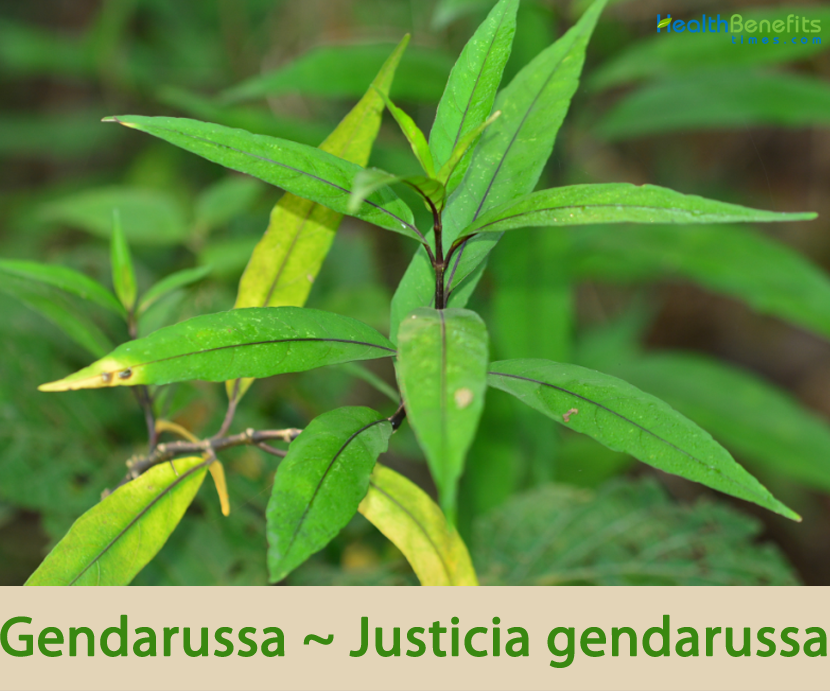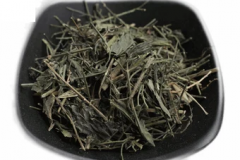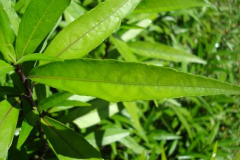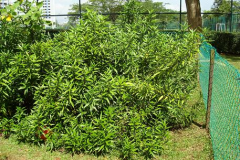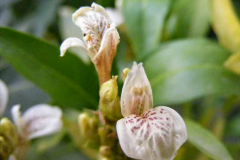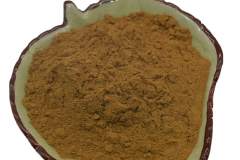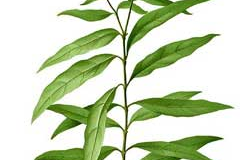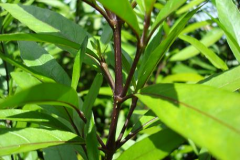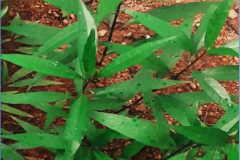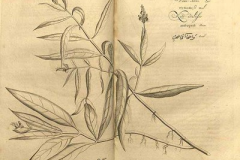| Gendarussa Quick Facts | ||
|---|---|---|
| Name: | Gendarussa | |
| Scientific Name: | Justicia gendarussa | |
| Origin | Native to China and is distributed widely across India, Sri Lanka, and Malaysia | |
| Shapes | Club-shaped, glabrous, 4-seeded capsules, about 1.2 cm long, and smooth | |
| Taste | Acrid, bitter | |
| Health benefits | Support for pains in the head, paralysis of one side of the body, facial paralysis, lumbago, amenorrhea, swellings, fevers, coughs, asthma, colic, eczema, cephalalgia, hemiplegia, facial paralysis, earache and hemicranias | |
| Name | Gendarussa |
|---|---|
| Scientific Name | Justicia gendarussa |
| Native | Native to China and is distributed widely across India, Sri Lanka, and Malaysia |
| Common Names | Black malabar nut, Black vasa, Water willow, Willow-leaved justicia, gendarussa, Asian Water-willow |
| Name in Other Languages | Assamese: Tita-bahak, bishalya karani, Jatrasiddhi Bengali: Jagatmadan (জগতমাদন) Brunei: Sarimbangun hitam Chinese: Qin qiu, Jiān wěi fèng (尖尾鳳), xiao bo gu (小驳骨), Xiǎo bó gǔ dān (小駁骨丹), Jiēgǔ cǎo (接骨草) English: Black malabar nut, Black vasa, Water willow, Willow-leaved justicia, gendarussa, Asian Water-willow French: Ayapana marron, Laliapana marron, Natchouli, Yapana malgache, Nitchouli, yapana marron Hindi: Nili nargandi (नीलि नर्गन्डि), Nilinirgundi, udisambhalu, Nili nargandi, Kala bashimb, Kala adulsa (काला अडुलसा) Indonesian: Gandarusa Javanese: Gandarusa Kannada: Aduthodagida (ಆಡುತೋಡ ಗಿಡ), Kaaralakkigida (ಕಾರಲಕ್ಕಿಗಿಡ), Karilakki (ಕರಿಲಕ್ಕಿ), Naachugaddi (ನಾಚುಗಡ್ಡಿ) Malay: Gandarusa, Sikapapar, Tolonsi Malayalam: Vātaṅkeālli (വാതംകൊല്ലി), karunochchi, vada-kodi Marathi: Bakas (बाकस), Kala adulasa (काळा अडुळसा), tev Oriya: Nilanirgundi Philippine: Kapanitulot Sanskrit: Bhutakeshi, Kasanah (कसनः ), Neel nirgundi, Nila nirgundi, Udisanbhalu, Vaidyasinha (वैध्यसिंहा), Viadyasinha, Gandharasa (गंधरस), Indrani, Kapika, krishnanirgundi Sinhalese: Kalu veraniya, Kalu weraniya Sundanese: Handarusa Tagalog: Kapanitulot Tamil: Karunochi, Karunochchi, vadaikkutti Telugu: Addasaramu (అడ్డసరము), gandharasamu (గంధరసము), nalla-noch-chili (నల్ల నొచ్చిలి) Thai: Chiang phraa mon, Pīk kị̀ dả (ปีก ไก่ดำ), S̄ạn phr̂ā mxỵ (สันพรัามอญ), Kradūk kị̀ (กระดูก ไก่ ) Unidentified: Vathamkolli Vietnamese: Thanh táo |
| Plant Growth Habit | Small, erect, much branched, shade-loving, quick-growing, deciduous, evergreen plant |
| Growing Climates | Most islands, provinces, chiefly along streams, in secondary and primary forests, and sometimes in thickets and roadsides |
| Plant Size | 0.8 to 1.5 meters high |
| Stem | Quadrangular, thickened at and above the nodes and internodes |
| Leaf | Leaves are opposite, lanceolate, green or variegated with short petioles, 7 to 14 centimeters long, 1 to 2.5 centimeters wide, pointed at the ends |
| Flower | Flowers are small, in 4- to 12-centimeters long spikes, terminal or in axils of leaves. Calyx-teeth are smooth, linear, and about 3 millimeters long. Corolla is nearly smooth, 1.5 centimeters long, white or pink, with purple spots. |
| Fruit Shape & Size | Club-shaped, glabrous, 4-seeded capsules, about 1.2 cm long, and smooth |
| Propagation | By stem cuttings and seeds. |
| Taste | Acrid, bitter |
| Plant Parts Used | Roots, leaves, Bark |
| Health Benefits |
|
| Other Facts |
|
Plant Description
Gendarussa is a small, erect, much branched, shade-loving, quick-growing, deciduous, evergreen plant that normally grows about 0.8 to 1.5 meters tall. The plant is fund growing in most islands, provinces, chiefly along streams, in secondary and primary forests and sometimes in thickets and roadsides. It prefers light, sandy soil in sun or partial shade. It likes constant moisture and well-draining soil. It is fast-growing, tolerable to many soil types and growth conditions, and generally free from pest and diseases. Stems are multi-branched, glabrous (smooth; not hairy or rough), terete (having a circular transverse section), thickened at and above the nodes and internodes.
Leaves
Its leaves are lance-shaped, lanceolate, 7–14 cm long and 1-2.5 cm wide and pointed at the ends. The color of the leaves can be white, green or grey and hairy on both sides. They are bitter, acrid and thermo genic.
Flowers
The rather small flowers grow as 4–12 cm long spikes at the end of branches or in leaf axils. Calyx teeth of the sepal’s cup are smooth, linear, and about 3 mm long. Corolla is nearly smooth, about 1.5 cm long, white or pink, with purple spots. The flowers are hermaphrodite and the bark has a dark purple.
Fruits
Fertile flowers are followed by club-shaped, glabrous, 4-seeded capsules, about 1.2 cm long, and smooth. The plant consists of a wide range of biologically active compounds like flavonoids, alkaloids, steroids and phenolic compounds.
Traditional uses of various parts of J. gendarussa
| S. No | Plant Parts | Uses |
| 1. | Leaf, stem | Bronchitis, inflammations, vaginal discharges, dyspepsia, eye diseases, tympanitis and fever |
| 2. | Leaf | Febrifuge |
| 3. | Leaf | Emetic |
| 4. | Oil | Eczema |
| 5. | Leaf infusion | Facial paralysis, hemiplegia and cephalalgia |
| 6. | Fresh leaf juice | Earache, hemi-crania |
| 7. | Whole Plant | Emmenagogue, emetic, diaphoretic |
| 8. | Leaf and flower top decoctions | Drink or as fumigation |
| 9. | Root decoction boiled in milk | Rheumatism, jaundice, chronic indigestion, fever, dysentery |
| 10. | Leaf decoction | Stimulant and emetic |
| 11. | Leaves (scattered among clothes) | Prevents insect attack |
| 12. | Water saturated with leaves | Fever and rheumatism |
| 13. | Leaf juice | Cough and colic in children |
| 14. | Leaf mixed with oil | Cures glandular swellings of the neck and throat |
| 15. | Leaves and tender stalks | Chronic rheumatism and other joint complaints |
| 16. | Leaves and stems | Emmenagogue, insecticide, in facial paralysis, otalgia, dysmenorrhea, amenorrhea, internal hemorrhages and ascites |
| 17. | Bark | Emetic |
| 18. | Shoot and leaves | Earache, rheumatism |
| 19. | Flowers | Eye pain |
| 20. | Flowers, barks, leaves | Cough |
| 21. | Plant juice | Hemostatic, antiseptic, nasal drops in nasal bleeding, dysentery, gargle, cuts and wounds, cancer, leucorrhoea, |
| 22. | Roots | Antiseptic, antidepressant and antipyretic, anti-venom, ulcerosis, leucorrhoea |
Health benefits of Gendarussa
Listed below are some of the popular health benefits of consuming Gendarussa
1. Increases blood circulation
Justicia Gendarussa is considered quite beneficial to increase blood circulation. Additionally, it can lead to the improving of many organs in the body, as the oxygen also will be increased. It also even makes the body healthier and feels better.
2. Treats fever
Some people believed that Justicia Gendarussa can treat fever effectively, just like any other herbal leaves. The condition you can treat probably as same as other treatment by taking the fresh or dried Gendarussa in a certain amount.
3. Cures bones fracture
Justicia Gendarussa is quite effective in curing bones fracture. Boil the leaves of the plant in 3 cups of water then you can drink the water in the morning and night for ½ cups. Regular consume of the drink reduces the fracture immediately.
4. Prevents rheumatism
Justicia Gendarussa can prevent rheumatism due to some essential nutrients contained in the plant. Drinking boiled water 30-60 grams fresh Gendarussa or 15-30 dried Gendarussa. Not only for rheumatism, it also for sprains and bruises.
5. Heals eczema
Justicia Gendarussa is effective in healing eczema or it is a condition when the skin is inflamed. It also happens because of allergies and the allergies should be tested to the doctor to prevent the condition.
6. Relieves headache
Gendarussa may relieve headache by taking a pitcher of Gendarussa leaves about 2 times a day regularly. The headache will be relieved as it also gives relax feeling. It is probably due to the increasing of oxygen in the body when you are taking the water of boiled Gendarussa.
7. Acts as cough treatment
The plant can be as a treatment of cough by taking skinny Gendarussa roots about 10 grams then boil it in three cups of water. Drink the water 2 times every half of cup.
8. Plays a roles as hormonal contraception
In Papua, Indonesia, the people used Gendarussa as hormonal contraception by taking its leaves. However, some studies are still needed to prove the benefit and they are conducted to Papuans.
Traditional uses and benefits of Gendarussa
- The leaf is antispasmodic, carminative and has antiperiodic properties.
- Leaves and tender young shoots are diaphoretic.
- Decoction is used in the treatment of chronic rheumatism.
- An infusion of the leaves is taken internally in the treatment of pains in the head, paralysis of one side of the body and facial paralysis.
- The leaf juice is used in the treatment of earache.
- The bitter root is anodyne, diaphoretic, diuretic and laxative.
- The root bark is emetic.
- Decoction of the plant is used to treat bruises.
- Decoction of boiled leaves is used for bathing during childbirth or for postpartum baths.
- In the Philippines the juice of 20 to 40 leaves or young shoots, extracted with water and a little wine, is used as emetic in coughs and asthma.
- Fresh juice of leaves is good for children’s cough and colic.
- It is also used for respiratory tract infections.
- Mix 2 ounces of fresh juice from leaves with 1 ounce of coconut oil as a poultice for rheumatism.
- Fresh leaves are used as topical to cure the edema of beriberi; also used for rheumatism.
- Fresh juice of leaves, mixed with mustard, is used as an emetic; also for asthma.
- Warmed salted leaves and tender stalks, in a bag, over musculoskeletal aches.
- Roots are boiled in milk and given for rheumatism, dysuria, fever, carbuncles, jaundice, and diarrhea.
- In the Antilles plant decoction or wine infusion (30 gm. in 1 liter of water) is used for intermittent fevers.
- Leaves rubbed with Crinum asiaticum and black pepper is used externally for lumbago.
- Leaves are scattered in-between clothes to protect from insects.
- Oil prepared from leaves is useful for eczema.
- In Kerala, leaves of J. gendarussa, Hydrocotyle javanica, and Pterospermum rubiginosum are ground and juice used to prepare decoction to use for rheumatism.
- It is said to be useful for the treatment of asthma, rheumatism and colic of children.
- It may have the potential to be the basis for a birth control pill for men.
- Willow-Leaf Justicia is reputed for its beneficial effects in Respiratory disorders like cough, cold, bronchitis, throat infections, pulmonary infections and allergic disorders like bronchial asthma.
- Dried seed powder mixed with fruit decoction and used as insect repellent.
- Leaves are taken internally against cough, body pain, fever and as a cardio tonic, and used externally to treat inflammation, wounds and allergy.
- Poultice of leaves are applied on inflammation.
- Leaf juice applied to check bleeding, also poured into ears for earache.
- Leaves decoction is a remedy for bloody diarrhea and fevers.
- Justicia gendarussa Burm. f is applied on the lower side of the naval region of the pregnant, the delivery will be smooth and
- In Indonesia, Justicia gendarussa Burm. F. is used to induce vomiting.
- In Malaysia, a decoction of 50g of roots is used to treat rheumatic arthritis; boiled with ginger rhizome and lime, it is used to alleviate bleeding cough.
- Decoction of the leaves is used to combat fever, promote menses, assuage stomach discomfort, check hemoptysis, alleviate cough, treat asthma, and to relieve the bowels of costiveness.
- Fresh leaves are pounded and used externally to treat pyoderma, lumbago and rheumatism.
- Paste of leaves mixed with vinegar is used to ease toothache.
- Justicia gendarussa is also used during the hot stages of malaria to combat fever and to treat leucorrhea.
- In Vietnam, the plant is used to resolve tumors, promote appetite, and to invigorate health.
- In India, the plant is used to treat bronchitis, soothe inflammation, and to promote digestion.
- Plant is traditionally used to treat chronic rheumatism, headache, earache, fever, cough, bronchitis, inflammation, bruises, paralysis of one side of the body and facial paralysis.
- The fresh leaf juice when dropped into the ears and nostrils, gives relief from earache and hemicranias.
- Root decoction boiled in milk is given for rheumatism, chronic indigestion, fever, jaundice and dysentery.
- Leaf juice prevents cough and colic in children.
- Glandular swellings of the neck and throat may be cured when the leaf mixed with oil is used.
- Leaves and tender stalks when put together with salt in a bag, warmed and externally applied, give relief from chronic rheumatism and other joint complaints.
- An infusion of the leaves is taken internally in the treatment of a wide range of conditions including pains in the head, paralysis of one side of the body and facial paralysis; lumbago, amenorrhea, swellings, fevers, coughs, asthma, colic, eczema, cephalalgia, hemiplegia, facial paralysis, earache and hemicranias.
- Leaves are also used in preparations to treat gonorrhea, amenorrhea and malaria.
- Fresh leaves are applied topically as a treatment for edema and swellings due to beriberi and rheumatism; to relieve headaches and pains.
References:
http://www.hear.org/pier/species/justicia_gendarussa.htm
https://pfaf.org/user/Plant.aspx?LatinName=Justicia+gendarussa
https://www.cabi.org/isc/datasheet/29289
https://gd.eppo.int/taxon/IUIGE
http://www.theplantlist.org/tpl1.1/record/kew-2330879
http://www.stuartxchange.com/Tuhod-manok.html
https://en.wikipedia.org/wiki/Justicia_gendarussa
https://www.flowersofindia.net/catalog/slides/Willow-Leaf%20Justicia.html
https://indiabiodiversity.org/species/show/230119


